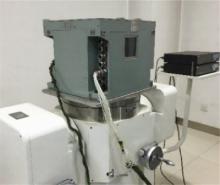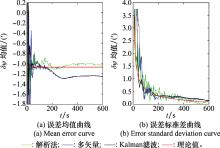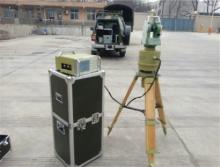Systems Engineering and Electronics ›› 2021, Vol. 43 ›› Issue (5): 1310-1315.doi: 10.12305/j.issn.1001-506X.2021.05.19
• Guidance, Navigation and Control • Previous Articles Next Articles
Initial alignment method based on information reuse and algorithm fusion
Zhihao XU1( ), Zhaofa ZHOU1,*(
), Zhaofa ZHOU1,*( ), Zhenjun CHANG1(
), Zhenjun CHANG1( ), Qi GUO2(
), Qi GUO2( )
)
- 1. Missile Engineering Institute, Rocket Force University of Engineering, Xi'an 710025, China
2. Unit 96902 of the PLA, Beijing 100015, China
-
Received:2020-07-01Online:2021-05-01Published:2021-04-27 -
Contact:Zhaofa ZHOU E-mail:1500105885@qq.com;zhaofa_zhou@163.com;changzj2105@163.com;Guoqi_academic@163.com
CLC Number:
Cite this article
Zhihao XU, Zhaofa ZHOU, Zhenjun CHANG, Qi GUO. Initial alignment method based on information reuse and algorithm fusion[J]. Systems Engineering and Electronics, 2021, 43(5): 1310-1315.
share this article
Table 1
Alignment results of different algorithms (°)"
| ψ | 多矢量 | 估计1 | 估计2 | 融合算法 |
| 1 | 9.650 7 | 9.655 9 | 9.652 7 | 9.651 7 |
| 2 | 9.638 4 | 9.625 7 | 9.631 3 | 9.634 9 |
| 3 | 9.667 9 | 9.698 2 | 9.676 1 | 9.672 0 |
| 4 | 9.650 0 | 9.678 4 | 9.658 5 | 9.654 2 |
| 5 | 9.647 4 | 9.649 8 | 9.645 9 | 9.646 7 |
| 6 | 9.639 1 | 9.642 0 | 9.639 0 | 9.639 1 |
| 7 | 9.641 1 | 9.640 7 | 9.644 1 | 9.642 6 |
| 8 | 9.632 6 | 9.616 0 | 9.629 4 | 9.631 0 |
| 9 | 9.633 4 | 9.629 8 | 9.638 7 | 9.636 0 |
| 10 | 9.640 3 | 9.645 5 | 9.643 1 | 9.641 7 |
| 均值 | 9.644 1 | 9.648 2 | 9.645 9 | 9.645 0 |
| 1σ (′) | 0.630 0 | 1.480 0 | 0.830 0 | 0.720 0 |
| 1 |
CHANG L B , HE H Y , QIN F J . In-motion initial alignment for odometer-aided strapdown inertial navigation system based on attitude estimation[J]. IEEE Sensors Journal, 2017, 17 (3): 766- 773.
doi: 10.1109/JSEN.2016.2633428 |
| 2 | WU Y , PAN X . Velocity/position integration formula part Ⅰ: application to in-flight coarse alignment[J]. IEEE Trans.on Aerospace and Electronic Systems, 2012, 49 (2): 1006- 1023. |
| 3 | WU Y , PAN X . Velocity/position integration formula part Ⅱ: application to strapdown inertial navigation computation[J]. IEEE Trans.on Aerospace and Electronic Systems, 2012, 49 (2): 1024- 1034. |
| 4 | CHANG L B , LI J S , CHEN S Y . Initial alignment by attitude estimation for strapdown inertial navigation systems[J]. IEEE Trans.on Instrumentation & Measurement, 2015, 64 (3): 784- 794. |
| 5 |
SILVA F O , HEMERLY E M , LEITE F W . On the error state selection for stationary SINS alignment and calibration Kalman filters-part Ⅰ: estimation algorithms[J]. Aerospace Science and Technology, 2017, 61, 45- 56.
doi: 10.1016/j.ast.2016.11.019 |
| 6 |
XU X , XU X S , ZHANG T , et al. ln-Motion Filter-QUEST alignment for strapdown inertial navigation systems[J]. IEEE Trans.on Instrumentation and Measurement, 2018, 67 (8): 1979- 1993.
doi: 10.1109/TIM.2018.2805978 |
| 7 | 严恭敏, 陈若彤, 郭鹍. 多矢量定姿的SVD和QUEST算法等价性分析[J]. 中国惯性技术学报, 2019, 27 (5): 568- 572. |
| YAN G M , CHEN R T , GUO K . Equivalence analysis between SVD and QUEST for multi-vector attitude determination[J]. Journal of Chinese Inertial Technology, 2019, 27 (5): 568- 572. | |
| 8 | CHANG L B , HU B Q , LI Y . Backtracking integration for fast attitude determination-based initial alignment[J]. IEEE Trans.on Instrumentation & Measurement, 2015, 64 (3): 795- 803. |
| 9 |
CHE Y T , WANG Q Y , GAO W , et al. An improved inertial frame alignment algorithm based on horizontal alignment information for marine SINS[J]. Sensors, 2015, 15 (10): 25520- 25545.
doi: 10.3390/s151025520 |
| 10 | MARKLEY F L . Attitude determination using vector observations: a fast optimal matrix algorithm[J]. The Journal of Astronautical Sciences, 1993, 41 (2): 261- 280. |
| 11 |
LIU X X , XU X S , ZHAO Y , et al. An initial alignment method for strapdown gyrocompass based on gravitational apparent motion in inertial frame[J]. Measurement, 2014, 55, 593- 604.
doi: 10.1016/j.measurement.2014.06.004 |
| 12 |
LIU Y T , XU X S , LIU X X , et al. A self-alignment algorithm for SINS based on gravitational apparent motion and sensor data de-nosing[J]. Sensors, 2015, 15 (5): 9827- 9853.
doi: 10.3390/s150509827 |
| 13 | 常振军, 张志利, 周召发, 等. 捷联惯导行进间对准位置更新与误差分析[J]. 系统工程与电子技术, 2020, 42 (1): 172- 178. |
| CHANU Z J , ZHANU Z L , ZHOU Z F , et al. Position updating and error analysis of SINS alignment for moving base[J]. Systems Engineering and Electronics, 2020, 42 (1): 172- 178. | |
| 14 | GAO F Q, DING C H, LIU J F. Initial alignment of strap down inertial navigation system using Kalman filter[C]//Proc. of the International Conference on Computer Application and System Modeling, 2010: 629-633. |
| 15 | MA Y F. Application of fault tolerant and federated strong tracking Kalman algorithm in integrated navigation system[C]//Proc. of the IEEE Conference on Consumer Electronics, Communications and Networks, 2011: 3946-3949. |
| 16 | 王琦, 高春峰, 应智慧, 等. 捷联惯导系统单位置初始对准可观测性分析[J]. 中国激光, 2018, 45 (1): 24- 29. |
| WANG Q , GAO C F , YING Z H , et al. Observability analysis of fixed position initial alignment of strapdown inertial navigation system[J]. Chinese Journal of Lasers, 2018, 45 (1): 24- 29. | |
| 17 |
LI J L , WANG Y , GU B , et al. State parameter adjustment filtering method of airborne POS based on instantaneous observable degree model[J]. IEEE Trans.on Insfirurree-nlafiion and Measurement, 2018, 67 (9): 2153- 2159.
doi: 10.1109/TIM.2018.2811262 |
| 18 |
SILVA F O , HEMERLY E M , LEITE F W . On the error state selection for stationary sins alignment and calibration Kalman filters-part Ⅱ: observability/estimability analysis[J]. Sensors, 2017, 17 (3): 439.
doi: 10.3390/s17030439 |
| 19 | 高亢, 任顺清, 陈希军, 等. 车载激光捷联惯导系统初始对准可观测性分析[J]. 中国激光, 2018, 45 (12): 47- 53. |
| GAO K , REN S Q , CHEN X J , et al. Observability analysis of vehicle-based-laser strapdown inertial navigation system initial alignment[J]. Chinese Journal of Lasers, 2018, 45 (12): 47- 53. | |
| 20 |
XU J N , HE H Y , QIN F J , et al. A novel autonomous initial alignment method for strap-down inertial navigation system[J]. IEEE Trans.on Instrumentation and Measurement, 2017, 66 (9): 2274- 2282.
doi: 10.1109/TIM.2017.2692311 |
| 21 |
LIU X X , XU X S , WANG L H , et al. A fast compass alignment method for SINS based on saved data and repeated navigation solution[J]. Measurement, 2013, 46 (10): 3836- 3846.
doi: 10.1016/j.measurement.2013.07.013 |
| 22 |
LIU X X , XU X S , LIU Y T , et al. A fast and high-accuracy transfer alignment method between M/S INS for ship based on iterative calculation[J]. Measurement, 2014, 51, 297- 309.
doi: 10.1016/j.measurement.2014.02.019 |
| 23 |
LI W L , WU W Q , WANG J L , et al. A novel backtracking navigation scheme for autonomous underwater vehicles[J]. Measurement, 2014, 47, 496- 504.
doi: 10.1016/j.measurement.2013.09.022 |
| 24 | YU H P , WU W Q , WU M P , et al. Stochastic observability-based analytic optimization of SINS multiposition alignment[J]. IEEE Trans.on Aerospace and Electronic Systems, 2015, 31 (3): 2181- 2192. |
| 25 | WAHBA G . A least squares estimate of satellite attitude[J]. SIAM Review, 1965, 7 (3): 409- 409. |
| 26 |
WU J , ZHOU Z B , GAO B , et al. Fast linear quaternion attitude estimator using vector observations[J]. IEEE Trans.on Automation Science and Engineering, 2018, 15 (1): 307- 319.
doi: 10.1109/TASE.2017.2699221 |
| 27 | SILSON P M G . Coarse alignment of a ship's strapdown inertial attitude reference system using velocity loci[J]. IEEE Trans.on Aerospace and Electronic Systems, 2011, 60 (6): 1930- 1941. |
| 28 | MARKLEY F L , CRASSIDIS J I . Fundamentals of spacecraft attitude determination and control[M]. New York: Springer, 2014. |
| 29 | WU M P , WU Y X , HU X P , et al. Optimization-based alignment for inertial navigation systems; theory and algorithm[J]. Aerospace Science and Technology, 2011, 15 (1): 1- 17. |
| 30 | 常振军, 张志利, 周召发, 等. 旋转捷联惯导抗晃动对准方法[J]. 系统工程与电子技术, 2019, 41 (9): 2087- 2091. |
| CHANU Z J , ZHANU Z L , ZHOU Z F , et al. Alignment method of rotating SINS with swinging base[J]. Systems Engineering and Electronics, 2019, 41 (9): 2087- 2091. |
| [1] | Zhe LIANG, Zhaofa ZHOU, Zhihao XU, Wenting LYU, Hui DUAN. Angular rate attitude algorithm based on multi-interval information correction [J]. Systems Engineering and Electronics, 2022, 44(5): 1636-1643. |
| [2] | Yajie XU, Yong XIAN, Bangjie LI, Leliang REN, Shaopeng LI, Weilin GUO. Method for improving the precision of hypersonic vehicle inertial navigation system based on neural network [J]. Systems Engineering and Electronics, 2022, 44(4): 1301-1309. |
| [3] | Renjie ZHAO, Kailong LI, Baiqing HU, Jiayu TIAN. SINS initial alignment algorithm based on improved quaternion damping error model [J]. Systems Engineering and Electronics, 2021, 43(11): 3330-3337. |
| [4] | Shiwen HAO, Zhili ZHANG, Zhaofa ZHOU, Zhenjun CHANG, Xianyi LIU. Influence of gravity disturbance on initial alignment of inertial navigation system [J]. Systems Engineering and Electronics, 2020, 42(7): 1575-1581. |
| [5] | Zhenjun CHANG, Zhili ZHANG, Zhaofa ZHOU, He CHEN. Position updating and error analysis of SINS alignment for moving base [J]. Systems Engineering and Electronics, 2020, 42(1): 172-178. |
| [6] | CHANG Zhenjun, ZHANG Zhili, ZHOU Zhaofa, CHEN He, ZHAO Junyang. Alignment method of rotating SINS with swinging base [J]. Systems Engineering and Electronics, 2019, 41(9): 2087-2091. |
| [7] | WU Huali, XIAO Zhicai, ZHOU Dawang, WANG Lingling. SINS installation error matrix decoupling method based on matrix decomposition [J]. Systems Engineering and Electronics, 2018, 40(5): 1091-1097. |
| [8] | CHEN He, ZHANG Zhili, ZHOU Zhaofa, LIU Pengpeng, ZHAO Junyang. Equivalence analysis between two quaternion based coarse alignment algorithms for SINS with inertial frame [J]. Systems Engineering and Electronics, 2018, 40(5): 1098-1103. |
| [9] | WANG Jian, ZHANG Tao, TONG Jinwu, YAN Yaxiong. Application of KF/UPF in initial alignment of large azimuth misalignment of SINS#br# [J]. Systems Engineering and Electronics, 2018, 40(12): 2775-2781. |
| [10] |
BEN Yueyang, SUN Yan, WANG Xiangyu, CHEN Hainan, YANG Lisheng, LIU Zhenghao.
Method of coarse alignment during voyages of vessel SINS aided by satellites
[J]. Systems Engineering and Electronics, 2018, 40(12): 2797-2803.
|
| [11] | CHENG Jianhua, MOU Hongjie, SUN Xiangyu, CHEN Daidai. Dual axis rotational modulation method based on SINS tetrahedron redundancy configuration [J]. Systems Engineering and Electronics, 2017, 39(8): 1801-1807. |
| [12] | XUE Haijian, GUO Xiaosong, ZHOU Zhaofa. SINS initial alignment method based on adaptive multiple fading factors Kalman filter [J]. Systems Engineering and Electronics, 2017, 39(3): 620-626. |
| [13] | HUANG Xiang-yuan, TANG Xia-qing, WU Meng. Research on moving base initial alignment of SINS/OD with reduced dimension CKF and smoother [J]. Systems Engineering and Electronics, 2016, 38(9): 2135-2141. |
| [14] | CHENG Jianhua, WANG Tongda, SONG Chunyu, YU Dongwei. Modified adaptive filter algorithm for shipborne SINS transfer alignment [J]. Systems Engineering and Electronics, 2016, 38(3): 638-643. |
| [15] | ZHAO Lin, LI Jiu-shun, CHENG Jian-hua, JIA Chun, WANG Qiu-fan. Schuler oscillation restriction of shipborne SINS#br# based on delayed alignment [J]. Systems Engineering and Electronics, 2016, 38(10): 2375-2380. |
| Viewed | ||||||
|
Full text |
|
|||||
|
Abstract |
|
|||||







